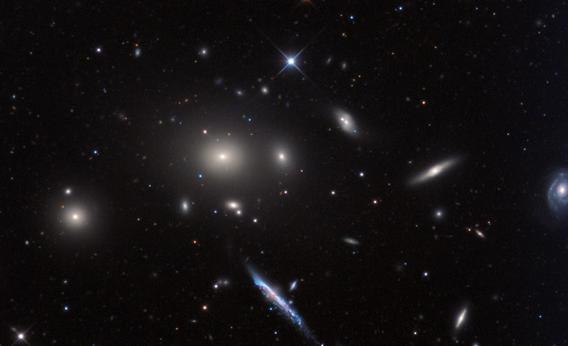Create a free profile to get unlimited access to exclusive videos, sweepstakes, and more!
The Lion’s Share of Galaxies

The Universe is built in layers. The fundamental units, you could argue, are stars. Some are solitary (like the Sun), some orbit each other as binary stars. By the hundreds or thousands they comprise clusters, and if you have a few billion to a few hundred billion, you get a galaxy.
Our Milky Way is part of a small group of about 50 other galaxies, most of which are smallish dwarfs. The next step up from a group is a galaxy cluster, which can contain hundreds to thousands of galaxies.
One of the nearest galaxy clusters is Abell 1367, more commonly called the Leo Cluster. A search of the astronomical literature shows itâs unclear how many galaxies can be considered Leo citizens; there are at least 70 major galaxies and perhaps many more. Itâs 300 million light-years away in the constellation of Leo (of course).
And itâs gorgeous. Astronomer Adam Block took an amazing image of the central region of the cluster using the 0.81 meter Schulman telescope on Mt. Lemmon in Arizona:
Thatâs just one part of the cluster, the core; click the picture to see the whole magnificent image Adam created. As you can see, thereâs one big fuzzy elliptical galaxy dominating the cluster core. Thatâs NGC 3842, and it sits at the center of mass of the cluster. It probably grew that large by cannibalizing other galaxies, eating them and adding to its girth.
Most of the galaxies in the cluster look yellow, even the spirals. That happens a lot in clusters. There is gas between the galaxies, and as they plow through it at high speed, attracted to each other by their mutual gravity, the gas inside the galaxies is stripped away. (The analogy I like is opening the windows in a car to air out a, um, foul odor.) If it had stayed in the galaxies, that gas wouldâve gone into making new stars, so in those stripped galaxies no stars have been made in a long time. The stars we see in them are old. Blue stars donât live long, so over time the galaxies redden.
The exception is that edge-on blue galaxy, called UGC 6697. It appears to be undergoing a burst of star formation, and thatâs likely due to the gas inside the galaxy getting compressed as it passes through the cluster gas. It lies on the outskirts of the cluster (itâs superposed on the core at the moment), where the amount of gas is just enough to trigger star birth but not enough to sweep away the galaxyâs gas completely.
Surveying the rest of the image yields more wonders. Near the top is a gorgeous spiral galaxy, canted to our line of sight, along with some smaller disturbed galaxies. These look like theyâve recently suffered collisions with other galaxies, another common occurrence in the busy environment of clusters. The face-on galaxy, cut off at the top of the frame, is a complete mess. Collisions between galaxies can really play havoc on their structure ⦠as weâll find out in a mere 4 billion years, when our Milky Way collides and merges with the massive Andromeda galaxy.
I also like this little trio of galaxies in the cluster. All three are spirals, but the one at the top seems to have no obvious arms (in that case itâs just called more generically a âdisk galaxyâ). The other two have strong bars, linear streams of stars across their nuclei. Our own galaxy is a barred spiral, though very different than these; the Milky Way is still busily churning out young stars, so our spiral arms are very obvious, and very blue.
The Leo Cluster is roughly the same distance away from the Earth as the far larger and richer Coma Cluster. Together, along with some smaller ones like the Hercules Cluster, they form the Coma Supercluster, the next layer of the hierarchy.
And it goes up from there. The Coma Supercluster, along with many others, forms a structure called the Great Wall, a vast complex hundreds of millions light-years long. Itâs one of the largest structures in the entire Universe, but there are many like it.
Itâs incredible, mind-numbing. The scale of the Universe crushes our sense of size, fills our capacity of awe to overflowing. I know some people despair when they think about this, but it has the opposite effect on me: I am uplifted. Not only is it wonderful enough that such things exist at all, but how astonishing is it that we can see them, study them, understand them? Perhaps not completely, of course, not yet and perhaps never in their entirety.
But we can try. And that makes us important, even at the tiny, tiny scale of this vast, vast Universe we inhabit.














